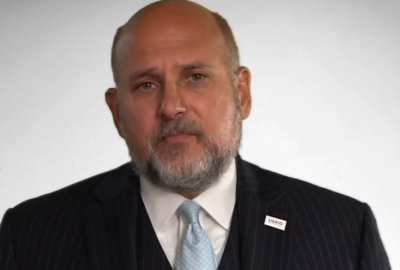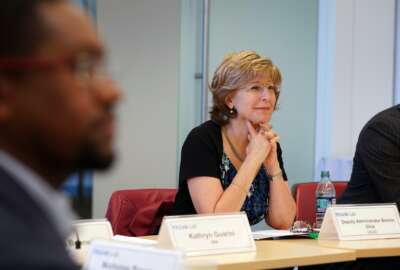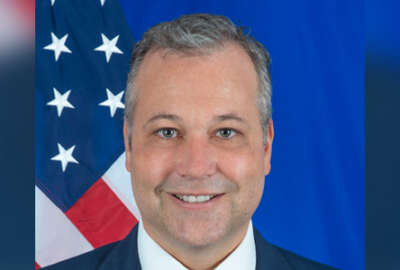
Providing international aid during a pandemic
The pandemic is exactly that - a pandemic. That means it's had a profound effect on how agencies operating overseas go about their work.
Best listening experience is on Chrome, Firefox or Safari. Subscribe to Federal Drive’s daily audio interviews on Apple Podcasts or PodcastOne.
The pandemic is exactly that – a pandemic. That means it’s had a profound effect on how agencies operating overseas go about their work. A case in point is the U.S. Agency for International Development. To deal with a problem with many sharp edges, USAID has embarked on what it calls an over -the-horizon strategic review. With what that is, how it works and its goals, Federal Drive with Tom Temin turned to the Acting Administrator of USAID John Barsa.
Interview transcript:
Tom Temin: Mr. Barsa, good to have you on.
John Barsa: Thanks, Tom, pleasure to be here with you.
Tom Temin: Give us the overview of how COVID and the pandemic has affected USAID and its work?
John Barsa: Well, it’s affected us in a myriad of ways. So certainly the United States, via USAID has been the most generous donor for decades to the international system. We’ve contributed billions of dollars in assistance in development and humanitarian assistance throughout the globe since our inception, in 1961 and certainly prior to that – our roots go back to the Marshall Plan. So what the pandemic was clearly on the face of it, it’s a health care crisis. So USAID has responded to the pandemic with assisting countries in ways that are tailored to the needs of specific countries: Access to clean water, increased systems, surveillance systems, public communications – so the generosity of American people through USAID has been quite effective. And certainly we’ve been the most generous country in the world, again, throughout this pandemic.
Tom Temin: Now it’s only a few years since we had the Ebola crisis and some of the other types of, what could have been bad pandemics. Are there lessons learned from those that the agency has been looking at?
John Barsa: Certainly, we came very close to saying we’ve been able to eradicate Ebola. But we had another outbreak. We didn’t go for a straight 30 days with no new cases. So USAID and CDC have been working overseas trying to eradicate Ebola. We made great progress. But certainly one of the things we learned from Ebola and our other works is in the Presidential Malaria Initiative, or combating AIDS, is how having robust health care systems allow countries to pivot and deal with stressors. So while people may not have known exactly when this zoonotic pandemic was going to hit and what way, our investment over decades in multiple countries to invest in health systems have enabled countries to be more resilient in their response to this unforeseen pandemic.
Tom Temin: All right, and that brings us to the over-the-horizon strategic review that USAID is undertaking. What is it and how does it work? What’s the format for this?
John Barsa: Certainly, my first day as acting administrator [of] USAID was April 13 of this year. I remember the day very well, because it was my birthday.
Tom Temin: Lucky you.
John Barsa: Lucky me. It was it was a wonderful gift. I’m very grateful for President Trump for the trust he invested in me by asking me to lead USAID. But certainly that early into the pandemic it was very clear to me that the COVID-19 pandemic was much, much more than just a health care crisis. It was also leading to economic disruption, and instability in democratic systems. It was a whole myriad of secondary and tertiary effects. So what I started soon after I took the helm here at USAID is I started an effort to look across all sectors of USAID programming to think ahead and quantify the secondary, tertiary effects of the pandemic. What was it going to mean about economic contraction in certain countries? Was this going to lead to increased food insecurity? Are we going to talk about mass unemployment in continents that are going to lead people to be more vulnerable to radicalization? What is this going to do to our democracy programming? Because taking a step back, I knew intuitively, the pandemic put decades of development work at risk, a risk for backsliding around the country. So the Over The Horizon Task Force, named aptly because this task force was asked to think past the immediacy of the inbox. Yes, USAID was responding like no other agency across the world, in international response to the pandemic. But I wanted to have a team of people to think beyond the immediacy of the now, to think of what’s coming up ahead. What are the challenges is going to be? So I’m very proud of the work this taskforce did. We not only consulted every expert within USA ID, we worked with over 74 different organizations, over 200 data sources, hundreds of interviews, think tanks, NGOs, all kinds of partners. We did not put our thumbs on the scale, and we let the data speak to us. And so what emerged was something that we knew intuitively we were going to see, but we didn’t know how or where. We knew that the pandemic was not going to hit the world uniformly. It was going to have harder effects in certain countries, in certain parts of the globe than others, but we didn’t know where and we didn’t know how. So now with this Over The Horizon study, we now have the ability to have data-driven discussions with Congress, with OMB and any number of external and internal entities about how USAID and USG need to position ourselves to meet the long-term challenges that are coming up over the horizon.
Tom Temin: We’re speaking with John Barsa. He’s acting administrator of the US Agency for International Development. And what are some specific things that are worth pointing out that the review revealed?
John Barsa: Well, we haven’t gone public with our focus countries yet. But we certainly had different areas of geographic concern along basically three axes of analysis. So patterns emerged. And so these patterns kind of came into three different areas. The first area is what we call strategic objective number one, is the need for us to build more stable, resilient systems in countries that are increasingly fragile due to COVID-19. So we are seeing entities like the Chinese Communist Party, trying to take advantage of other countries suffering from the pandemic, with one-sided loan debt diplomacy. So along one axis, we’re seeing how the COVID pandemic is challenging countries in their governance areas. So countries that are fragile, are now brittle. So that was one trend that came up. The other trend was that we need to focus more on the micro economic aspects of the pandemic, in terms of at the family level, access to education. So we’re at risk of losing generations of young people because of lack of education. This could have ramifications in terms of large scale unemployment. You know, we’ve made progress over the years with giving girls access to education systems in countries where they didn’t have it before. There’s a risk of backsliding.
Tom Temin: In countries like that there could be schools that are closed because of the pandemic. But everybody can’t go home and get online like they can here.
John Barsa: Correct, absolutely. So the whole idea about distance learning, it’s great in certain developed countries, but in many countries where USAID work distance learning isn’t an option. So because of the study, we’re able to focus on where are these countries, where can these investments be better made to have the greatest impact in terms of access education for young people, and access education for girls? This has also driven home the point of the importance of economic empowerment and inclusion for women. For any country to think they can have full economic recovery without the participation of half of their potential workforce is folly. So this really drives home the point on the necessity for full economic inclusion women into societies. The third strategic objective comes to health systems itself. So we talked earlier about how USAID has invested over decades in health systems. In many countries, the necessity to respond to the pandemic has led to a shifting of attention and resources away from regular immunizations, and other health care treatments. So what we’re finding is that we have to make more investments, or help more in certain countries with their health systems writ large to deal with this pandemic, and any other pandemics that may come forward. Again, so certainly, robust health systems like ours, we can walk and chew gum – we need to make sure other health systems have the ability to deal with these outside stressors.
Tom Temin: And of course, the pandemic is changing and morphing all the time. Is the strategic review a living type of thing that you can review and go back to the data from time to time?
John Barsa: So certainly the Over The Horizon review was a full-blown, all-hands-on-deck analysis of what we can tell right now of what might be coming in the next year, or two, or three, or four or five over the horizon. What we found was there’s some best practice in some of the analytical standards and methodologies we have. So now USAID is standing up a strategic foresight unit, which we did not have before, to take some of these best practices derived from the Over The Horizon analytical work to have a group here at USAID that is continuing looking forward for emerging trends. So we can better inform our missions on how to make decisions on the field. We can help our missions get a heads up, or think ahead about some challenges that they may not be seeing in their inboxes right now, but maybe coming around the corner.
Tom Temin: And in the meantime, how has the workforce been affected from USAID that does have to go overseas and matriculate in some of those countries?
John Barsa: Well, certainly it, again, from my first day of work on April 13, the pandemic was really starting to hit us hard. I laid out three priorities. One of the priorities was a necessity to think through the challenges over the horizon, which led to the horizon study. The first one was the health and safety of the USAID workforce. And my second priority was to figure out ways to ensure that the United States government, USAID did not retreat from any corner of the globe. So we were able to implement some innovative approaches and thinking, such as increased usage of IT systems. So we were very successful, more successful than other government agencies in terms of our ability to do telework, for example. So we were able to get some novel systems in place, and we validated some of the techniques necessary for teleworking. The other thing that enabled us to continue functioning was the ability to give some added flexibilities to our Foreign Service nationals who operate in the field. Foreign Service nationals are key elements of the US workforce. They are usually born-and-raised natives of the countries in which we operate, and who work at our missions on any number of projects and career paths. So they’re a valuable part of our workforce. So with the pandemic, we explored ways to give them greater authorities and capabilities. So based on that, increased telework, our innovative use of IT systems, we were able to ensure that we were able to continue to operate in every corner of the globe.
Tom Temin: John Barsa is acting administrator of the U.S. Agency for International Development. Thanks so much for joining me.
John Barsa: Well, thank you very much for having me, always a pleasure.
Tom Temin: We’ll post this interview along with a link to more information at FederalNewsNetwork.com/FederalDrive. Hear the Federal Drive on demand. Subscribe at Apple Podcasts or wherever you get your podcasts.
Copyright © 2025 Federal News Network. All rights reserved. This website is not intended for users located within the European Economic Area.
Tom Temin is host of the Federal Drive and has been providing insight on federal technology and management issues for more than 30 years.
Follow @tteminWFED
Related Stories





